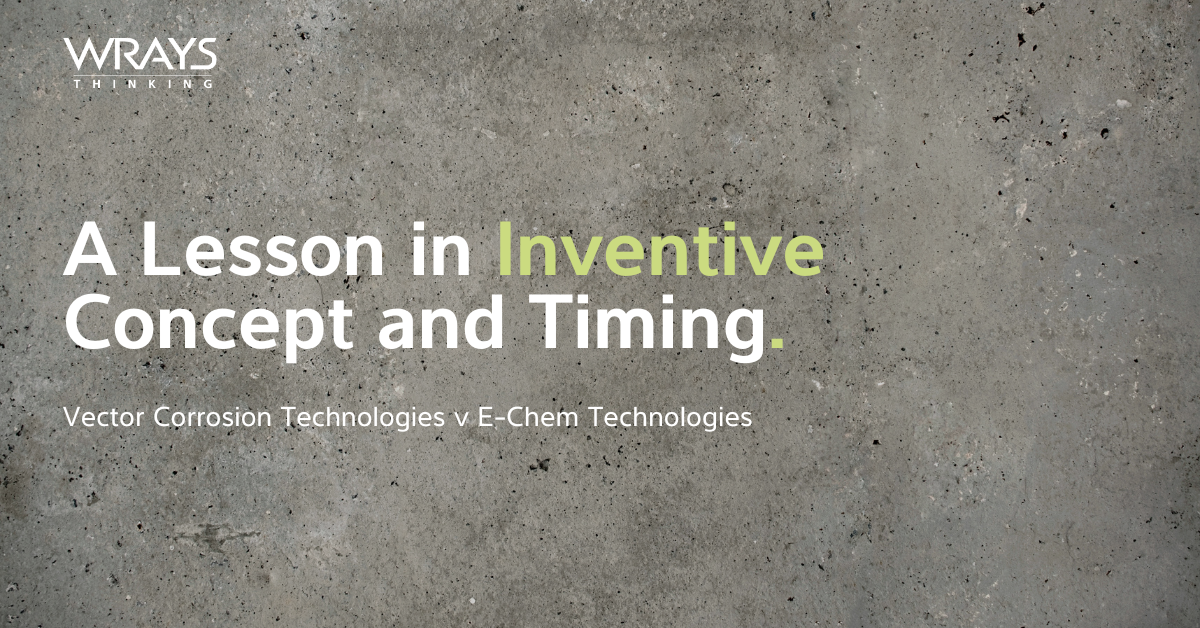Vector Corrosion Technologies v E-Chem Technologies
The Federal Court of Australia recently heard a patent entitlement dispute (Vector Corrosion Technologies Limited v E-Chem Technologies Ltd [2022] FCA 188) in relation to Australian Patent 2006224340 entitled “Treatment process for concrete”. Vector Corrosion Technologies Limited (Vector) claimed that it was solely or jointly entitled to the Patent registered to E-Chem Technologies Ltd (E-Chem).
At issue here and a message to all patentees is the date at which the inventive concept was conceived. In determining which party was entitled to the patent, the timing of events was crucial.
The patent application was filed on 14 March 2006 with an earliest priority date of 16 March 2005. The three inventors, Dr Nigel Davidson, Mr Adrian Roberts and Dr Gareth Glass were also the applicants. The invention was in the field of products and systems for the electrochemical protection of steel and/or prevention of corrosion in reinforced concrete structures. During the period 2002-2004, all three of the inventors were employed by the corrosion company Fosroc International Limited (Fosroc). In March 2004, Dr Glass left Fosroc and established E-Chem. Mr Roberts and Dr Davidson joined E-Chem in May 2004 and July 2004 respectively. The first priority application was filed the following year in the names of the three inventors.
In January 2009, Vector purchased Fosroc’s corrosion business. Vector claimed that the inventors conceived of the invention while still employed by Fosroc and that Vector had purchased the patent and the relevant contracts. On this basis, Vector claimed it was solely or jointly entitled to the E-Chem patent. Vector sought rectification of the Patent Register to have itself recorded as the sole or joint owner of the Patent. E-Chem asserted that the inventors conceived of the inventive concept after leaving the employ of Fosroc and that Fosroc had no rights. Additionally, there were no rights for Vector to purchase as they resided with E-Chem, not Fosroc.
The Court discussed the Principles of Entitlement under Australian Patent Law and identified that there is a difference between the discovery of an idea (i.e. the inventive concept) and the reduction to practice. The Court also made a distinction between inventiveness (relevant to patentability) and the inventive concept (relevant to entitlement). The formation of the inventive concept didn’t necessarily mean the formation of a ‘definite and permanent idea of the complete and operative invention’.
Vector argued that the manner in which an idea is carried out or its reduction to precative was irrelevant to the identification of the incentive concept. By contrast, E-Chem’s position was that the inventive concept included the formation of a definite and permanent idea of the complete and operative inventive.
Jagot J. stated that the inventive concept of the ‘heart of the invention’ was the use of the anode in two modes, in the first phase for a short period with a high impressed current (but lower than the prior art) supplied through an external power source and in the second phase using the same anode as a sacrificial anode to generate a continuous low galvanic current and to maintain the passive conditions induced by the first phase. It came down to an issue of timing and Her Honour determined that the inventive concept was conceived after all of the three inventors left Fosroc.
Rectification of the Patent Register is at the Court’s discretion. Vector’s delay in bringing the action certainly did not help their cause to have them recorded as sole or joint owners of the Patent. While it was not necessary to decide on this, Jagot J. indicated that rectification of the Register after up to ten year’s delay may have significantly prejudiced E-Chem and she may not have exercised her discretion to do so.

